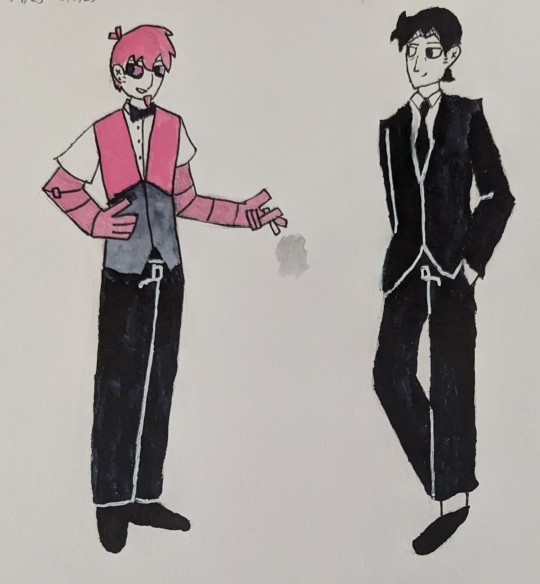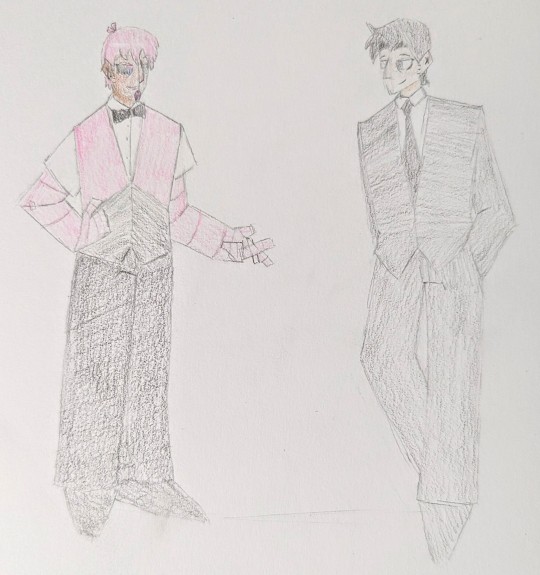#also my new sketchbook is an actual coloured pencil one instead of mixed media so
Explore tagged Tumblr posts
Text
1 year redraw that i am not happy with 👍


#mostly mean the colouring that im not happy with#i need to start using markers honestly#these two just dont look right without the bright ass colours#i feel like my actual sketching ability is better but im still very unsure about colouring#also yes i forgot the smoke i already packed up my pencils so yknow#this is like a thing i do btw#when i finish a sketchbook i redraw whatever is one the first on the last page#also my new sketchbook is an actual coloured pencil one instead of mixed media so#the paper is smooth so i hope the pencils look a bit nicer#klepto talks to himself#klepto's art tag
3 notes
·
View notes
Note
Hello! I wanna start drawing again and I'm really fond of your style, I was wondering, do you have any drawing tips? ❤️
okay sorry this took a couple days to reply to because i wanted to think about it, but i think my main advice is to divide up your artistic time into practice and art. this drawfee video on how to practice effectively explains it really well (this section is at around 13 minutes, i haven’t watched the rest of it yet bc it’s a long vid but i bet there’s other good advice in there too): practice is input, drawing is output. practice is learning new information about things you don't know how to do – you're not making a final piece.
practice is things like:
experimenting with different ways of holding the pen/pencil. holding a pen/pencil for drawing is different than how you'd hold it for writing – you want to hold it higher up, and use looser arm movements. different angles will give different effects (see here). holding a pen for a tablet is different to both a traditional pencil and a writing grip. if you have a tablet that picks up on palm contact, try getting a drawing glove so that you don't have to hold your hand at an unnatural angle. draw different lines and shapes and get used to the different effects you can make.
experimenting with different ways of moving your hand. a general rule to follow here is the bigger the shape, the more of your arm you should use to draw it. a lot of people draw primarily with just their fingers or wrists moving because they feel more control there, which is great for fine detail work but doesn't translate well to bigger sweeping shapes, and thats where you end up with wobbly lines or having to draw several scratchy lines instead of one smooth curve. if you want more confident lines you need to draw from the elbow, or the shoulder. it takes some getting used to but it's definitely worth it for keeping your drawings lively instead of stiff, and your wrist will also feel less strain.
learning to draw basic 3 dimensional shapes. boxes, cylinders, spheres. just draw a whole lot of them from different angles.
learning how to break down a complex form into basic shapes. a good way to do this is tracing – tracing has a bad rap as being stealing, but as long as you're not uploading a traced image and passing it off as your own it's a great way to train your eye to understand how forms work together, particularly for something complex like anatomy. draw over an image and break it down into basic shapes. then try to copy those shapes onto your own paper without tracing. do it over and over until you're better at it. (this method of redrawing is called iterative drawing, it's a great practice technique).
theres broader practice and then narrow. having a mix of both is good: quick sketching a whole figure some days, other days really focusing in on like “this is how a nose work”. go with what feels right in the moment.
and then the output, the actual drawing, is when all this practice pays off - these are your pieces that you work on to show people, or the things that you want to make, this is where you chase your creativity and passion. keeping them separate really helps to stop your art feeling like a chore and keeps you from overworking your full pieces (incorporating too much practice into your creative art); it also stops you stagnating or becoming frustrated with your lack of improvement (not practicing enough).
you don't have to be super strict with yourself about when to do which thing; you'll probably go through phases of doing a lot of practice, and then phases of doing a lot of drawing. if you're really struggling with one thing, that's often a sign that you need to do more of the other to balance things out.
other advice:
learn to be bad at art. this is good during practice with things like timed figure drawing or whatever where you just don't have time to make it good, but it's also good in drawing/creating: just letting yourself make “bad” or silly or quick things for the fun of it or to get an idea out. nothing has to be perfect and the earlier you learn to be bad at art the quicker you'll get good at art, and the more you'll enjoy it too
to expand on that, while tablet drawing is great, i've found that i improve a lot more rapidly when i do at least some of my practice a) on paper but also b) in pen or marker or paint, anything non-erasable. the ability to undo and erase infinitely in digital art is great for full pieces but doing your practices in pen means you're forced to be lot less precious and so you learn quicker how to be more decisive and confident with your lines because whatever you put there, you’re stuck with it.
if you're stuck, try something completely out of your comfort zone. use different materials, restrict yourself to a specific colour palette, ask for prompts, set a timer. sometimes there's just too much choice about what to do and it can be paralysing: giving yourself a totally arbitrary restriction can actually push you to be more creative and to get out of a rut (recommending more drawfee here, their random shapes challenge videos are a really good example of this)
you don't have to find your style. it'll find you. it's good to observe what you like about other people's art and try to consciously think about it, it can be really good to ty and mimic those elements yourself during your practice, but for your actual drawings you don't need to think about your style because as your ability improves it will come out naturally.
this applies mostly to traditional, but try to have your paper tilted slightly rather than flat on the desk – i prop my hardback sketchbooks up on a book. if you have your paper flat then you're more likely to get a little bit of a perspective distortion from top to bottom, especially if you're working from a reference, because you're looking at the paper from a different angle than you're looking at the reference so it can look fine when you're drawing but then when you look at it head-on it's just a little off. it also makes it easier to not hunch up over it and get a backache.
FLIP THAT CANVAS. i don't know why this works but its a time-honoured artist technique for making sure that there's reasonable symmetry especially for drawing people: draw your picture out, then flip it. you'll be able to see a lot clearer where the proportions are off. make changes, flip it again, keep doing that. it's harder with traditional media to do this but if you have some tracing paper you can turn that over, or just take a photo of your work and flip that.
a little frustration can be good if it’s motivating you, but if it's so much that you're tearing up your drawings or wanting to quit, you either need to change up your approach for a while or you need to take a bit of a break. i know people say you have to draw every day and if that works for you then do that, but personally, i don’t: i go through phases of drawing all the time then not at all for a few weeks, and that works better for me than forcing myself to work on it every day and i often come back to it a lot better because i’ve given all the practice time to actually sink in. breaks are an important part of learning, whether its hour or a day or a week of just walking the fuck away from the sketchbook and doing something else.
stretch your arms and wrists often, especially if you're drawing for several hours. here's the routine i use, it’s only ten minutes but it makes a big difference. and if you've overdone it and your hand or wrist or back is hurting, don't push through it. drawing is surprisingly physical and i’ve fucked my hands up real bad several times not listening to a slight ache and having it turn into full on RSI
i hope some of that helps! there are a lot more specifics i could get into about a million different things but the overall gist of this is that you should be aware of all the different options you have and can dabble in, and try to find a balance of learning and creating that allows you to improve without sucking all the joy out of it.
15 notes
·
View notes